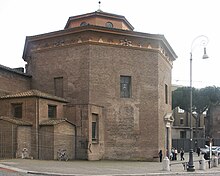Baptistery
When the site had been the palatial dwelling of the Laterani, before Constantine presented it to Bishop Miltiades, the spring formed the water source for the numerous occupants of the domus.
Cassiodorus, in a letter written in AD 527, described a fair held at a former pagan shrine of Leucothea, in the still culturally Greek region of southern Italy.
[3] Baptisteries belong to a period of the church when great numbers of adult catechumens were baptized and immersion was the rule.
They did not seem to be common before the emperors Gratian, Valentinian, and Theodosius made Christianity the state religion in the Edict of Thessalonica (i.e. before the 4th century).
They had to be large because a bishop in the early church would customarily baptize all the catechumens in his diocese and the rite was performed only three times a year, on certain holy days.
According to the records of early church councils, baptisteries were first built and used to correct what were considered the evils arising from the practice of private baptism.
As soon as Christianity had expanded so that baptism became the rule, and as immersion of adults gave place to sprinkling of infants, the ancient baptisteries were no longer necessary.
The central area, with the basin of the font, is an octagon around which stand eight porphyry columns, with marble capitals and entablature of classical form.
Attached to one side, toward the Lateran basilica, is a porch with two noble porphyry columns and richly carved capitals, bases and entablatures.
The circular church of Santa Costanza, also of the 4th century, served as a baptistery and contained the tomb of the daughter of Constantine.
Many others, in Syria for example, were found in late 19th and early 20th-century archaeological research, as were some belonging to churches of North Africa.
[5] In most of Europe the early Christian practice of having a distinct baptistery building, useful when large numbers of adult catechumens were being instructed and then baptised in groups by immersion, had lapsed by the Late Middle Ages, when baptisms were normally of infants, and used sprinkling with holy water rather than immersion.







